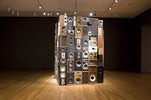
How do speakers work
, by Haim Deutsch, 1 min reading time

, by Haim Deutsch, 1 min reading time
The basics
Forgive us for being slightly too technical in this article, but any audiophile will want to know how the kit they’re investing in actually works. If you know how they work, you can fix their problems
The speaker driver (the circular vibrating thing) transforms electrical waves that have been amplified into pressure waves in the air, which are detected by your ears. The electrical waves are sent by a playback device - the turntable cartridge, in your case.
But how do the electrical waves meet the speaker driver in the first place? Your amplifier supplies a signal to two terminals at the reverse of a speaker. They pass the current into a coil of wire suspended in the gap between the poles of a permanent magnet. The coil moves forward and backward inside the magnetic field whilst the current passing through it alternates its direction with the applied signal. The centre of the speaker cone is attached to one end and gets driven forward and back by the movement of the coil. The cone is held in place by an airtight surround. The surrounding air is pushed and pulled by the moving cone, thus creating pressure waves in the air, or sound.
Tweeters and woofers
Looking at a speaker in your setup, you may find that it has more than one speaker driver, usually a smaller one above a larger one. They are known as tweeters and woofers: tweeters above and woofers below
While a single driver can handle most of the audible spectrum on its own, it faces difficulties in doing so. A small driver can’t move a lot of air and therefore will produce bass at a suboptimal level compared with larger drivers.
And whilst larger drivers move more air, they become more ‘directional’ as the number of frequencies increases. This increases the wavelength, which produces a less balanced sound for a single speaker. The solution, then, is different sizes of driver, each one reproducing a tailored range of frequencies - such as bass, middle, and treble. Tweeters take the highs, while woofers take the lows.